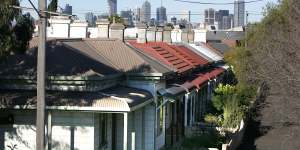Analysis from investment group Jarden tips rental price growth will accelerate beyond its current 15-year high of 7.8 per cent thanks to a combination of strong migration,low rental vacancy rates and soft dwelling investment.

Rent price increases are forecast to hit a high not seen since the GFC this year.Wayne Taylor
Jarden forecasts rental inflation in Australia will reach 10 per cent through this year – a high not seen since the GFC in 2008 – and then remain at 8 per cent through 2025,and stay high in 2026.
The firm’s chief economist,Carlos Cacho,said there was a lag of about 18 months between asking rents and the ABS rental inflation figure,which is an average of all rents. He said growth in advertised rents was running at about 10 per cent,and was forecast to remain at a high 8.5 per cent this year before easing to 4.3 per cent in 2025.
“This is likely to maintain upward pressure on inflation and will likely remain a challenge for the RBA as it seeks to bring inflation back to its 2 to 3 per cent target,” he said.
Cacho said that even with the 10 per cent increase in the maximum rate of Commonwealth rent assistance announced in the recent federal budget,the underlying pressures on rents from lack of housing supply to the rebound in migration would persist.
“Ultimately,we see the strong rise in rents,along with broader services inflation,as the main drivers of inflation over the next two years,” he said.

Rental pressure is not confined to capital cities,separate research has found.
CoreLogic figures show 37 of the country’s 50 largest non-capital significant urban areas recorded record rent increases in the year to April.
Overall regional rents rose by 6.3 per cent over the year to April,up from 4.9 per cent in the year to January.
CoreLogic Australia economist Kaytlin Ezzy said housing affordability had continued to deteriorate through the start of this year for both prospective home buyers and tenants.
“The outlook for regional housing markets will heavily depend on demographic trends,housing supply,localised economic drivers and the outlook for interest rates,” she said.
The fight over migration and its role in the housing crisis has continued to heat up. Both the federal government and the Coalition are committed to cutting migration to help reduce pressure on the housing market,while the Greens say wealthy property investors are to blame for the shortage of affordable homes.
In its recent budget,Labor committed to capping international student numbers to get net overseas migration down to 260,000 a year,while the shadow treasurer now says the Coalition will slash net overseas migration by 37 per cent in their first year in power if they win the next election.
“If we’re going to have Australians being able to get into a home,to realise the great Australian dream of home ownership,then we’ve got to have a situation where we’ve got a housing supply balanced with immigration,” he said on Sky on Sunday morning.
“We’ve seen extraordinary numbers coming in. They are numbers that our housing supply simply can’t cope with.”
But Greens leader Adam Bandt said big corporations and developers were to blame for the country’s housing crisis.
“Well,my view on migration at the moment is this:Labor and Liberal are engaged in a migrant-bashing race to the bottom as a distraction from the real issues facing this country every time that there is a cost-of-living crisis,” he said on ABC’sInsiders on Sunday.
“We can build enough homes for everyone to have an affordable place to live,OK. I’m not going to spend the next year in the lead-up to an election blaming migrants for a problem that they didn’t cause.”
The federal government announced just over $6 billion in new spending to help address the housing crisis,including a further $1 billion this financial year to help states and territories build more homes.
The government has acknowledged its target of building 1.2 million homes over five years starting from July is ambitious,but Treasurer Jim Chalmers said more homes needed to be built to take pressure off the housing market.
“We’re building homes in every community around Australia,every state and territory,because we know that rents are too high. And that’s why we’re providing more rent assistance and building more homes,” he said on Thursday.